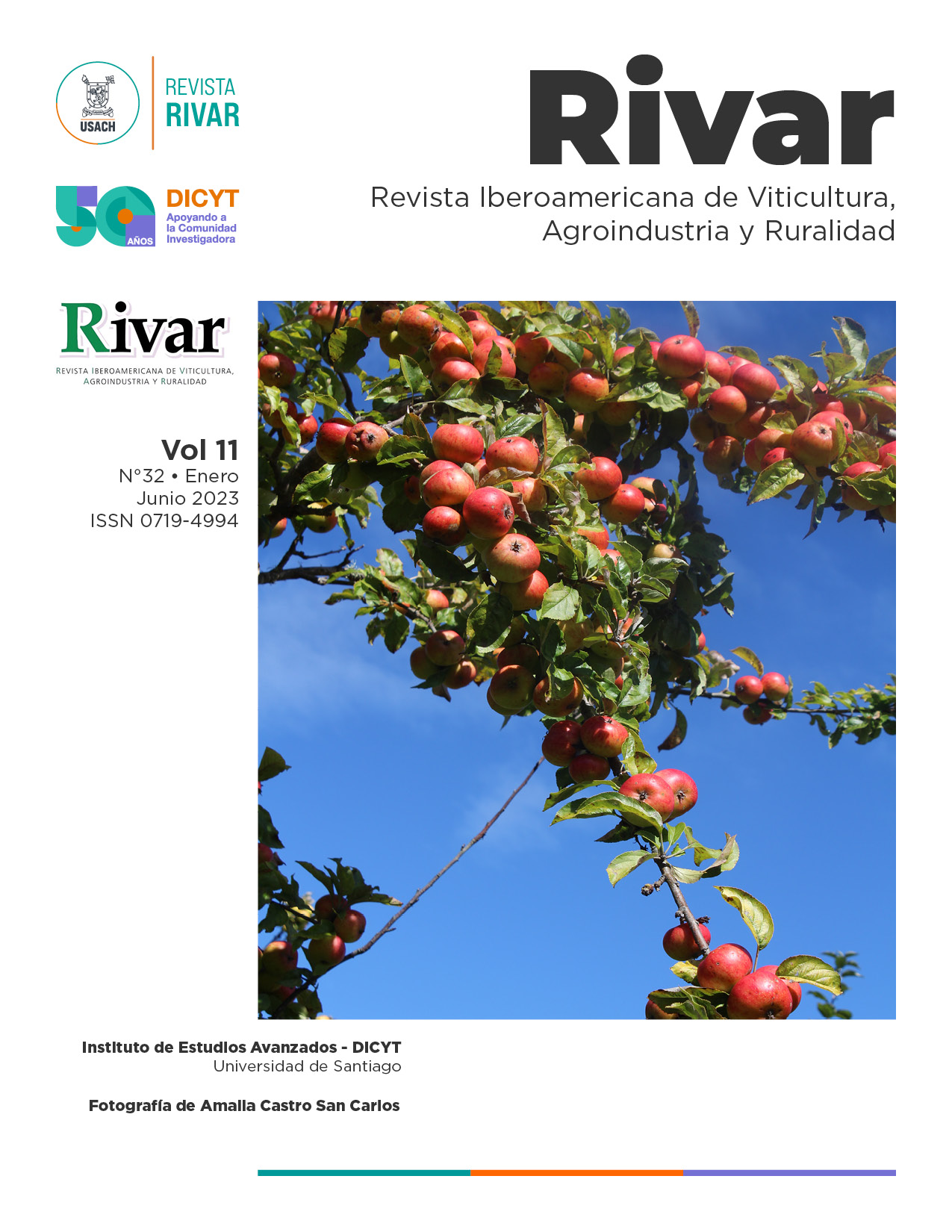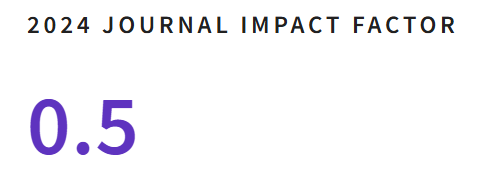Accumulation and Degradation of Solutes Vitis vinifera L. Berries in Contrasting Climates
DOI:
https://doi.org/10.35588/8znt5686Keywords:
Tannat (Vitis Vinifera), climate, ripening stages, berry compositionAbstract
Grape ripening is a complex process conditioned by climatic factors, which influence the evolution of solutes and define its composition. The objective of the study was to evaluate the behavior of the red Tannat variety in contracting climatic situations, considering the dynamics of berry growth, the rate of accumulation and reduction of solutes during ripening, and their composition at harvest. The trial was installed in two regions, warm and temperate climate, in rainfed commercial vineyards, during 2018 and 2019. Primary berry composition at ripening and secondary composition at harvest were determined. Multivariate analysis and comparison of means (Fisher’s LSD test) were performed. The climatic type (region) conditions the evolution of solutes at ripening, but their interaction with annual conditions determines berry composition. The annual variability is explained by rainfall, with a direct influence on the duration of the cycle and the ripening, size, and composition of the berry. In warm climates, there is greater sensitivity to the ripening year effect, with a strong influence on the rapid phase. In temperate climates, the greater stability between years results from a thermal condition more favorable to ripening processes.
Downloads
References
Abeysinghe, S.K., Greer, D.H. y Rogiers, S.Y. (2019). The Effect of Light Intensity and Temperature on Berry Growth and Sugar Accumulation in Vitis vinifera “Shiraz” under Vineyard Conditions. Vitis, 58(1), 7-16. http://dx.doi.org/10.17660/actahortic.2016.1115.18
Antalick, G., Šuklje, K., Blackman, J.W., Schmidtke, L.M. y Deloire, A. (2021). Performing Sequential Harvests Based on Berry Sugar Accumulation (mg/berry) to Obtain Specific Wine Sensory Profiles. OENO One, 55(2), 131-146. https://doi.org/10.20870/oeno-one.2021.55.2.4527
Candar, S., Korkutal, İ., Bahar, E. y Aktas, F.B. (2023). Exploring the Relationship between Leaf Water Potential, Defoliation, and Grape Berry Physical Properties of Merlot (Vitis vinifera L.) Grapevine. International Journal of Agriculture Environment and Food Sciences, 7(3), 517-532. https://doi.org/10.31015/jaefs.2023.3.6
Carbonneau, A. (1995). La surface foliaire exposée – guide pour sa mesure. LeProAgretVit, 9, 204-212.
Cataldo, E., Eichmeier, A. y Mattii, G.B. (2023). Effects of Global Warming on Grapevine Berries Phenolic Compounds – A Review. Agronomy, 13, 2192. https://doi.org/10.3390/agronomy13092192
Conde, C., Silva, P., Fontes, N., Dias, A.C.P., Tavares, R. M., Sousa, M. J., Agasse, A., Delrot, S., Gerós, H. (2007). Biochemical Changes throughout Grape Berry Development and Fruit and Wine Quality. Global Science Books Food, 1(1), 1-22.
Coombe, B.G. (1995). Growth Stages of the Grapevine: Adoption of a System for Identifying Grapevine Growth Stages. Australian Journal of Grape and Wine Research, 1, 104-110. https://doi.org/10.1111/j.1755-0238.1995.tb00086.x
Deloire, A., Rogiers, S., Šuklje, K., Antalick, G., Zeyu, X. y Pellegrino, A. (2021). IVES Technical Reviews. IVES Technical Reviews Vine & Wine. https://doi.org/10.20870/IVES-TR.2021.4615
Ferrer, M., Echeverría, G. y Carbonneau, A. (2014). Effect of Berry Weight and its Components on the Contents of Sugars and Anthocyanins of Three Varieties of Vitis vinifera L. under Different Water Supply Conditions. South African Journal for Enology and Viticulture, 35(1), 103-113. https://doi.org/10.21548/35-1-989
Ferrer, M., González-Neves, G., Echeverría, G. y Camussi, G. (2012). Plant Response and Grape Composition of Vitis vinifera L. cv Tannat in Different Climatic Regions. Journal of Agricultural Science and Technology, 2, 1252-1261.
Ferrer, M., Pedocchi, R., Michelazzo, M., González-Neves, G. y Carbonneau, A. (2007). Delimitación y descripción de regiones vitícolas del Uruguay en base al método de clasificación climática multicriterio utilizando índices bioclimáticos adaptados a las condiciones del cultivo. Agrociencia Uruguay, 11(1), 47-56. https://doi.org/10.31285/AGRO.11.768
Ferrer, M., Pereyra, G., Salvarrey, J., Arrillaga, L. y Fourment, M. (2020). “Tannat” (Vitis vinifera L.) as a Model of Responses to Climate Variability. Vitis, 59(1), 41-46. https://doi.org/10.5073/vitis.2020.59.41-46
García de Cortázar Atauri, I., Brisson, N. y Gaudillere, J.P. (2009). Performance of Several Models for Predicting Budburst Date of Grapevine (Vitis vinifera L.). International Journal of Biometeorology, 53, 317-326. https://doi.org/10.1007/s00484-009-0217-4
González-Neves, G., Gil, G., Barreiro, L., Ferrer, M. y Franco, J. (2006). Composición fenólica de las uvas de las principales variedades tintas de Vitis vinifera cultivadas en Uruguay. Agrociencia Uruguay, 10(2), 1-14. https://doi.org/10.31285/AGRO.10.918
González-Neves, G., Gil, G., Ferrer, M., Charamelo, D., Balado, J., Bochicchio, R., Gatto, G. y Tessore, A. (2010). Prediction of the Colour and Polyphenolic Composition of the Young Red Wines from the Phenolic Potential of the Grapes. International Journal of Food Science & Technology, 45(9), 1843-1851. https://doi.org/10.1111/j.1365-2621.2010.02343.x
Gutiérrez-Gamboa, G., Zheng, W. y Martínez de Toda, F. (2021). Current Viticultural Techniques to Mitigate the Effects of Global Warming on Grape and Wine Quality: A Comprehensive Review. Food Research International, 139, 109946. https://doi.org/10.1016/j.foodres.2020.109946
Instituto Nacional de Vitivinicultura (INAVI). (2022). Estadísticas de viñedos 2021: Datos nacionales. INAVI.
Kuhn, N., Guan, L., Dai, W.Z., Wu, B.H., Lauvergeat, V., Gomes, E., Li, S.H., Godoy, F., Arce-Johnson, P. y Delrot, S. (2014). Berry Ripening: Recently Heard through the Grapevine. Journal of Experimental Botany, 65(16), 4543-4559. https://doi.org/10.1093/jxb/ert395
Ojeda, H. (2007). Riego cualitativo de precisión en vid. Revista de Internet de Viticultura y Enología, 5, 1-10.
Ortega Farías, S., Acevedo, C., Moreno, Y. y Pardo, C. (22 y 23 de julio de 2004). Deshidratación prematura de bayas en cv. “Merlot”: ¿Un desequilibrio hídrico del viñedo? En Tópicos de actualización en viticultura y enología (pp. 1-17). Pontificia Universidad Católica de Chile. Santiago, Chile.
Ribalta-Pizarro, C., Muñoz, P. y Munné-Bosch, S. (2021). Tissue-Specific Hormonal Variations in Grapes of Irrigated and Non-irrigated Grapevines (Vitis vinifera cv. “Merlot”) Growing Under Mediterranean Field Conditions. Frontiers in Plant Science, 12. https://doi.org/10.3389/fpls.2021.621587
Rienth, M., Torregrosa, L., Sarah, G., Ardisson, M., Brillouet, J.M. y Romieu, C. (2016). Temperature Desynchronizes Sugar and Organic Acid Metabolism in Ripening Grapevine Fruits and Remodels their Transcriptome. BMC Plant Biol, 16(1), 164. https://doi.org/10.1186%2Fs12870-016-0850-0
Rogiers, S.Y., Greer, D.H., Hatfield, J.M., Orchard, B.A. y Keller, M. (2006). Solute Transport into Shiraz Berries during Development and Late-Ripening Shrinkage. American Journal of Enology and Viticulture, 57, 73-80. http://dx.doi.org/10.5344/ajev.2006.57.1.73
Shahood, R., Torregrosa, L., Savoi, S. y Romieu, C. (2020). First Quantitative Assessment of Growth, Sugar Accumulation and Malate Breakdown in a Single Ripening Berry. OENO One, 54(4), 1077-1092. https://doi.org/10.20870/oeno-one.2020.54.4.3787
Van Leeuwen, C. et al. (2019). An Update on the Impact of Climate Change in Viticulture and potential adaptations. Agronomy, 9(9), 514.
Vila, H.F., Paladino, S.C., Nazrala, J.B. y Lucero, C.C. (2009). Manual de técnicas analíticas para la evaluación de compuestos fenólicos y otros componentes de la uva. INTA, Facultad de Ciencias Agrarias UNCuyo, AACREA y COVIAR.
Winkler, A.J. et al. (1974). General Viticulture. University of California Press.
Zhang, X.Y. y Keller, M. (2015). Grape Berry Transpiration is Determined by Vapor Pressure Deficit, Cuticular Conductance, and Berry Size. American Journal of Enology and Viticulture, 66(4), 454-462. https://doi.org/10.5344/ajev.2015.15038
Zhang, X.Y., Wang, X.L., Wang, X.F., Xia, G.H., Pan, Q.H., Fan, R.C., Wu, F.Q., Yu, X.C. y Zhang, D.P. (2006). A shift of Phloem unloading from symplasmic to apoplasmic pathway is involved in developmental onset of ripening in grape berry. Plant Physiology, 142(1), 220-232. https://doi.org/10.1104/pp.106.081430









